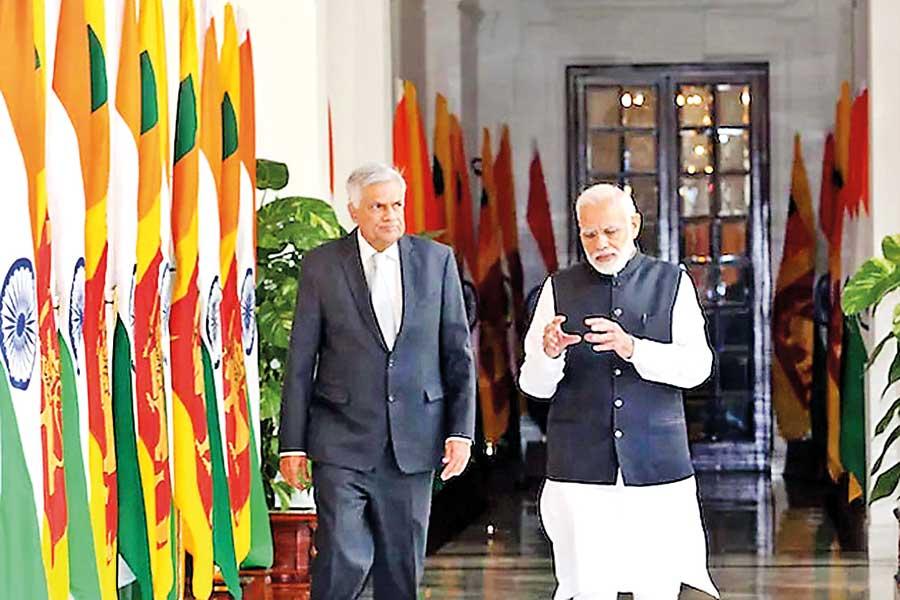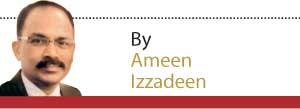21 Jul 2023 - {{hitsCtrl.values.hits}}

File Picture: India’s Prime Minister Narendra and Sri Lanka’s then Prime Minister Ranil Wickremesinghe Modi are seen walking down the corridor of New Delhi’s Hyderabad House in 2018
Today, India is pursuing a more aggressive neighbourhood-first policy and more assertive Act East policy, and it is politically, militarily, and diplomatically much stronger than ever to implement it and dictate terms to its neighbours
When Ranil Wickremesinghe set foot in India yesterday for the first time since he assumed power as Sri Lanka’s president, it was not to celebrate the completion of his first year in office. The business is geopolitics.
The business is geopolitics.
He arrived in an India that was militarily, economically, and diplomatically much stronger than the India he visited officially as Prime Minister in September 2015, one month after the United National Front he led won the general election and formed a new government, or subsequently in 2017 and 2018.
It was a big puzzle for India watchers here why New Delhi waited so long to extend him an invitation for an official tour, though the tradition requires every new Sri Lankan leader to make his or her first official port of call to New Delhi.
Perhaps this was because the situation in Sri Lanka during the first few months of Wickremesinghe’s presidency was not conducive or appropriate for him to make an official visit to India. Perhaps, India was concerned about the political uncertainty in the early days of his presidency. None could predict then whether Wickremesinghe could survive even a month in the presidency given his party’s near-zero strength in Parliament.
Perhaps, India was not happy with how the Wickremesinghe presidency responded to India’s protests over the visit of what it claimed to be a Chinese spy ship to Sri Lanka’s China-run Hambantota Port. Despite India’s protests, the vessel, which China insisted was a research ship, made a port call in Hambantota. This happened in Wickremesinghe’s second month into the presidency.
But the puzzle became a bigger enigma when there was still no India visit for Wickremesinghe, while he undertook several foreign visits -- to the United Kingdom twice, Japan twice, France and the Philippines for purposes ranging from official funerals to economic summits.
In the meantime, India’s Prime Minister Narendra Modi was also busy visiting country after country, apart from attending to his busy prime ministerial duties and electioneering schedules as the leader of the Bharatiya Janatha Party (BJP). He visited the United States and Egypt recently. Last week, he was in France and the United Arab Emirates. He has undertaken one too many visits in recent years, prompting the opposition to question them in Parliament.
In response, India’s External Affairs State Minister V Muraleedharan told Rajya Sabha, the parliament’s upper house, “The objective of Prime Minister’s visits abroad has been to foster closer relations with foreign countries and promote India’s engagements at the regional and global level. Such visits are an important means by which India serves its national interest and implements foreign policy objectives.”
Yet, to attribute Wickremesinghe’s unusual one-year delay in showing up in New Delhi to a problem with the time slots in his and Modi’s tight schedules is an excuse that many in diplomatic circles would not buy. At the same time, the claim that the Modi government, by not granting an early appointment, was keeping Wickremesinghe in his place beggars belief.
This is because India provided US$ 4 billion in assistance to the beleaguered Sri Lankan government, which was hurtling towards bankruptcy, unable to honour repayments on its massive US$ 46 billion foreign loans. Additionally, India supported Sri Lanka in securing the International Monetary Fund’s Extended Fund Facility of US$ 3 billion and navigating foreign debt restructuring. Sri Lanka would have been in a much worse predicament without this support. So, the reason for the delay in extending the facilitating Wickremesinghe’s India visit could be one of these or an amalgam of all these possibilities.
With such assistance, India did make a powerful political statement: Sri Lanka’s real all-weather friend is not China, but India. The dollars that flowed in from India helped end long queues for essential items such as fuel and gas and overcome the looming food crisis. China was sending mainly words of assurance to Sri Lanka to overcome the country’s worst-ever economic crisis, brought about, among other factors, by unsolicited and unproductive projects China heaped on Sri Lanka.
However, there is no altruism or free lunch in international politics. Neither India nor China puts Sri Lanka above their respective national interests.
When President Wickremesinghe holds talks with Indian leaders, the undercurrent will be geopolitics. Apart from bilateral matters such as investments, power devolution in Sri Lanka, and the dispute over Indian poaching in Sri Lankan waters, the China factor is expected to dominate India’s concerns. The Sri Lankan side is not unprepared to assuage India.
Today, India is pursuing a more aggressive neighbourhood-first policy and more assertive Act East policy, and it is politically, militarily, and diplomatically much stronger than ever to implement it and dictate terms to its neighbours.
India plays its international role as a superpower in the making. After all, last Friday, it sent a spacecraft to the moon, brushing shoulders with the US, Russia and China in an exclusive space club.
India holds the G20 presidency. Its Prime Minister was invited to hold talks with G7 leaders in May this year in Hiroshima. It is a member of the new Asian security alliance called the Quad, which many analysts see as a growing China-focused military grouping, though India rejects such an interpretation.
India is also emerging as a major power in the Middle East, with Israel, Saudi Arabia, the United Arab Emirates (UAE), and other nations wooing closer defence and economic ties with it. In the Middle East, India has formed a separate Quad with Israel, the US, and the UAE. During Modi’s visit to Egypt last month, it was said India offered a multi-billion-dollar credit line to the Arab world’s most populous country to overcome its financial crisis. On the foreign currency front, India’s neighbours, including Sri Lanka, and other countries are expressing willingness to adopt the Indian rupee as a currency for bilateral trade.
India is asserting its independence in defence and foreign policy, sending a clear message to the world that its presence in various West-dominated forums is in no way an indication of its leaning towards the West, with its Ukraine policy, seen as pro-Russia, being a classic example. India believes it is, in its own right, a centre of power in the emerging global order and has no need to latch on to other centres of power.
It is with such an India that Wickremesinghe is holding talks during his 36-hour official visit today.
But Sri Lanka’s President is a veteran of the diplomatic balancing act. He knows there is much more geopolitics than meets the eye in India’s Lanka policy, be it about the power devolution to Sri Lanka’s Northern and Eastern provinces in keeping with the India-sponsored 13th Amendment, foreign investments in wind power projects in the north, the Trincomalee oil farms, or proposed energy connectivity between the two countries.
It is interesting to note that in October, Wickremesinghe, in a diplomatic masterstroke, will be making his first official visit to China, India’s Indian Ocean rival but a co-partner in the economic club BRICS—seen as a competitive group to the G7—and the Shanghai Cooperation Organisation, a Eurasian security and economic alliance.
10 Jan 2025 10 minute ago
10 Jan 2025 1 hours ago
10 Jan 2025 2 hours ago
10 Jan 2025 2 hours ago
10 Jan 2025 2 hours ago